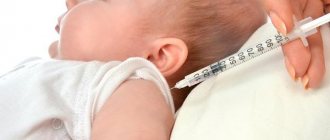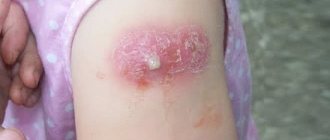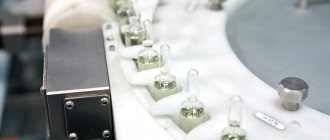One of the very first vaccinations that a newborn baby receives while still in the maternity hospital is BCG.
This vaccine is intended for specific prevention of a deadly type of tuberculosis. The abbreviation BCG (French version of BCG) stands for Bacillus Calmette-Guerin. This vaccine is prepared from a strain of weakened live tuberculosis bacillus, specially grown in an artificial environment.
It is effective in reducing the severity of tuberculosis in children under two years of age. In addition, the vaccine prevents the development of deadly disseminated forms of tuberculosis and meningitis. It is important to know what the BCG vaccination should look like and how it will heal. After the vaccine is administered, it is necessary to carefully monitor the reactions that occur in the baby.
What should a BCG vaccination look like?
In the absence of contraindications, the first BCG vaccination is given to the baby on days 3-5 from the moment of birth, and again when he reaches the age of seven.
The injection site is the outer side of the left shoulder, namely, the border between the upper and middle third. If vaccination is successful, immediately after the injection a papule with a diameter of 5 mm to 1 cm forms on the surface of the skin. After approximately 15-20 minutes, it completely resolves.
A month after this manipulation, the child’s body begins to respond to the injection. A pustule with purulent contents appears at the injection site. Parents of the baby should not worry, since such a reaction is absolutely normal.
There is no need to treat the pimple that appears with ointments and medications.
BCG vaccination, how and when it can be done
As a rule, this vaccination is given to newborns before discharge from the hospital. Vaccination is also permissible on the seventh day, although most often it is done on the third. If necessary, revaccination is carried out at 7 and 14 years of age. Adult children are vaccinated only if they have a negative mantoux test.
The serum is produced in powder form; immediately before vaccination, the powder is diluted with physiological solution. The injection is done with a tuberculin syringe.
The injection is made into the left shoulder from the outside. The route of vaccine administration is intradermal (up to the middle layer of the dermis). At the same time, the baby receives either a single puncture or two, but they are located closely. Over the course of several months, the baby’s protective function of the body is formed, and the injection site heals, leaving a scar.
There are cases when it is contraindicated to vaccinate in the shoulder. Then they choose a different place, the main thing is the presence of a thick layer of skin. As a rule, this place becomes the child’s thigh.
How is vaccination tolerated: normal and deviations
Reactions to the BCG vaccination in a baby may vary. Therefore, parents need to know what is considered normal and what requires immediate medical intervention.
Redness of the BCG injection site, accompanied by barely noticeable suppuration, is normal. However, only if the redness does not spread to surrounding tissues.
A deviation from the norm should be considered severe suppuration, in which swelling and redness are observed in the surrounding tissues. This may indicate infection has entered the wound.
In such cases, the child needs to be examined by a pediatrician, since other routine vaccinations may be contraindicated until the condition returns to normal.
A normal reaction to the BCG vaccination is slight swelling, which disappears on its own after 2-3 days.
The injection site may itch - this is due to the processes of healing and regeneration of the skin. This phenomenon is normal, but you should not allow the wound to be scratched to avoid infection. Therefore, it is advisable at this stage to apply a gauze pad to the vaccination site.
In individual cases, children may develop a fever after vaccination. If it does not exceed 37.5-38⁰С, everything is in order. At temperatures above 38⁰C, it is recommended to consult a doctor.
Parents should also pay attention to complicated conditions that require immediate medical attention:
- Cold abscess, which forms 1-1.5 months after the injection. This condition indicates that the drug was administered not intradermally, but subcutaneously. Eliminated by surgery.
- Inflammation of the lymph node is a consequence of the spread of microbacteria from the skin into the lymphatic system. If the lymph node has enlarged to a size exceeding one centimeter, surgical treatment is necessary.
- The appearance of an extensive ulcer, the diameter of which exceeds 10 millimeters, indicates hypersensitivity to the components of the drug. In such cases, the doctor performs local treatment. And data on sensitivity must be included in the child’s medical record.
- A keloid scar in the form of redness and swelling of the skin at the injection site is an individual reaction to the vaccine. In this case, repeated vaccination for vaccination upon reaching 7 years of age is contraindicated.
- Osteitis, or bone tuberculosis, which develops 0.5-2 years after vaccination, occurs in approximately 1 child out of two hundred thousand vaccinated.
- Generalized BCG infection is a serious complication against the background of serious immune disorders. A rare phenomenon that occurs no more often than 1 child in a million.
Vaccination against tuberculosis
It is held in 59 countries around the world. However, a number of countries with a low incidence of tuberculosis (approximately 10 per 100,000) vaccinate BCG only in risk groups.
Vaccine
protects against severe forms of primary tuberculosis, but does not protect against infection and disease in case of close contact with the mycobacterium excretor.
2 drugs are registered in Russia:
- BCG –
live lyophilized tuberculosis vaccine, Russia; - BCG-M
- live lyophilized tuberculosis vaccine with a reduced number of microbial cells, Russia;
Both vaccines contain lyophilized (dried) mycobacteria in a 1.5% sodium glutamate solution. The preparation contains both live and killed cells. Their high ratio allows you to get a good result and a minimum of unwanted reactions with a smaller dose of the vaccine.
One ampoule of BCG (BCG-M) contains 20 or 10 doses of vaccine. Both drugs are prepared from the same inoculum - Mycobacterium bovis.
Vaccination against tuberculosis
performed on healthy children aged 3-7 days. Currently, newborns are vaccinated with the BCG-M vaccine, since it has proven to be less reactogenic.
If for any reason a child has not been vaccinated against tuberculosis before the age of two months, the vaccination is given only after the Mantoux test, if its result is negative.
Revaccination is carried out at 7 and 14 years of age for uninfected children with a negative Mantoux test. In areas with an incidence of less than 40 per 100 thousand hours. Only one revaccination is allowed - at 14 years of age.
Administration of the BCG vaccine (BCG-M)
is carried out only after a careful examination by a doctor in the vaccination room or a specially designated room in the maternity hospital (newborn department), in the morning. No other vaccinations or parenteral (requiring damage to the skin) tests are performed on this day.
BCG vaccine (BCG-M) is used in a dose of 1.05 (0.025) mg per 0.1 ml of solvent (sterile saline solution). The drug is placed strictly intradermally at the border of the middle and upper third of the left shoulder, after treating the skin with 70% alcohol. The vaccine injection site should not be treated with anything or bandaged.
Immunogenicity
Mycobacteria, entering the vaccinated person’s body, form long-term specific protection against tuberculosis. The mechanism of action of the vaccine is to localize the primary infection (we are talking about infection with Mycobacterium tuberculosis) and limit the spread of infection throughout the body. The level of protection when vaccinated with BCG (BCG-M) is 70-85%, and almost 100% protection against such dangerous forms of tuberculosis as disseminated tuberculosis and tuberculous meningitis is formed.
Contraindications for vaccination.
- Premature babies and children with intrauterine malnutrition who weigh less than 2500 g are not vaccinated with BCG. The use of the BCG-M vaccine is permissible for weights of 2000 or more. Such babies are vaccinated when they reach the required body weight.
- Acute illness. Vaccination is carried out after relief of its manifestations.
- Immunodeficiency state – both primary and associated with HIV infection. This provision does not apply to children born to HIV-infected mothers, since most of these babies are not infected, but are only carriers of antibodies. But even in the case of intrauterine infection, the child’s immune system functions normally for a long time.
- Presence of family members with a generalized form of BCG infection.
Contraindications for revaccination.
- Immunodeficiency conditions, cancer. When prescribing drugs that suppress immunity and radiation therapy, vaccination is carried out no earlier than 12 months after the end of the course of treatment. Active or past tuberculosis, infection with mycobacteria.
- Positive or questionable Mantoux reaction.
- Complications from previous administration of the BCG vaccine
- Acute or exacerbation of a chronic disease. Revaccination is carried out after the symptoms of the disease have stopped.
- Contact with infectious patients. The vaccination is given at the end of the quarantine period or the maximum incubation period for the disease for which there was contact.
Reaction to vaccine administration.
At the site of vaccine administration, 4-6 weeks after vaccination, the following are successively formed: a compaction (papule), suppuration with the formation of a crust (pustule) and a scar with pigmentation. The formation of a scar measuring 3-10 mm occurs by 2-4 (sometimes longer) months in 90-95% of babies. These local changes must be recorded by the doctor or nurse in the child’s record.
Complications.
The frequency of registered complications is about 15 per 100,000 primary vaccinations (0.015%).
Structure of complications (the total number of complications is taken as 100%).
Local skin lesions
- subcutaneous infiltates -1.5% (induration of 15-30 mm at the site of vaccine administration, often accompanied by enlargement of regional lymph nodes);
- cold abscesses – 37.8% (tumor-like formation, soft in the center, accompanied by enlarged axillary lymph nodes),
- ulcers – 3.3% (defect of skin and subcutaneous fat at the site of vaccine administration)
- regional lymphadenitis – 49.1% (painless enlargement of lymph nodes, sometimes with the formation of a fistula);
- keloid scar is a tumor-like formation. Which differs from a normal scar after BCG in the following:
- - very dense
- - capillaries are visible in the thickness of the formation
- - round shape
- - smooth glossy surface
- - color to bluish or brown
- - accompanied by itching
BCG infection persistent
bone damage - osteitis, usually in children with defects of the immune system - 4.9%;
Generalized BCGit – 0.8%
the most severe complication observed in the presence of congenital immunodeficiency
How does healing proceed in newborns: stages of scar healing
In newborn babies, approximately 4-6 weeks after the vaccine is administered, a small spot is noticeable. Soon it becomes indurated, like a mosquito bite.
It reaches approximately 5-10 millimeters in diameter.
This papule is characterized by a color change to white, red, purple or bluish.
At the next stage, instead of a spot slightly raised above the surface of the skin, a pustule appears, inside of which there is liquid. Initially it is transparent, but over time it becomes cloudy.
Approximately 4-6 months after the injection (this period is individual for each child), the bubble bursts, and in its place a crust forms, which can change several times. Under no circumstances should you peel it off until it has completely healed. Otherwise, this process will drag on for a long time. At this stage, the vaccination site must be protected from water.
After six months, the scab falls off naturally in most babies. Instead, a scar remains, reaching 4-6 millimeters in diameter. It initially has a reddish tint, but later turns pale pink. The baby's scar is finally formed by the age of one year.
Why a scar may not form after BCG
Cases have been identified where there is no trace of the BCG vaccination. The reasons are as follows:
- poor quality vaccine;
- incorrectly performed procedure;
- the presence of innate immunity.
Innate immunity against tuberculosis is rare. Antibodies are already present in the blood, so locally introduced bacteria are immediately destroyed. There is no mark on the shoulder after BCG vaccination, since no papule is formed.
The first two cases indicate that immunity has not developed. But why there is no reaction to BCG in a newborn, you need to figure it out, this is an alarming signal about the need for testing or revaccination.
If BCG does not appear within a day after the vaccine is administered, a Mantoux test is first done. It helps to identify signs of pulmonary tuberculosis and other forms in the early stages. A weak pathogen is injected under the skin on the forearm: if a papule of normal size is formed, there is resistance. If the test result is negative, there is no immunity, and infection may have occurred.
If there was a scar, but it disappeared
A trace of BCG first forms in newborns, and disappears during the period from infancy to 7 years, this means the end of the vaccine’s effect. Most adults do not have a visible BCG scar on their arm. In children, the gradual disappearance confirms a decrease in immunity.
How long does it take for the vaccine injection site to heal?
The healing period of the BCG vaccination site for each baby is individual.
However, in any case, this period is quite long.
On average, healing time can range from one month to six months.
Sometimes there is no reaction to the vaccine. This may be due to:
- innate immunity to tuberculosis;
- existing infection;
- development of other inflammatory processes in the body.
Therefore, to identify the exact cause, it is necessary for the baby to be examined by a doctor.
If there is no trace of the vaccination left, the baby must undergo examination, based on the results of which further measures will be determined:
- in case of innate immunity, vaccination should be carried out at the age of seven years;
- if tuberculosis infection is detected, the doctor prescribes appropriate treatment;
- if the immune response is weak, re-vaccination is carried out after some time.
The longer the vaccination site takes to heal and the larger the remaining scar, the stronger the child’s immunity against a dangerous disease.
BCG: how long does it take to heal?
The main symptoms are noted a month or a month and a half after the procedure. How long it takes for BCG to heal in infants cannot be said with certainty: the duration of the reaction depends on the characteristics of the body and many other factors. In most cases, the formation of an abscess lasts almost two months, and the formation of a crust and scar takes about a month. How BCG heals at 7 years old also depends on the immune system. Normally, the Mantoux test should look like an injection point.
During the period of formation of immunity to tuberculosis, the following processes occur in the child’s body, which are not pathological:
- redness of the skin at the injection point;
- a small abscess at the stage of scarring of skin tissue;
- purulent accumulations in the wound, not accompanied by tissue swelling and severe redness;
- itching, signaling that the vaccine is working and the skin is healing;
- swelling of the skin, confirming the presence of an immune response to the administered drug;
- a slight increase in temperature, lasting no more than 3 days, provoked by the appearance of antibodies to the vaccine in the blood.
If the temperature after the injection lasts more than 3 days, the child should be urgently taken to the pediatrician.
How to care for a papule after vaccination in a baby
In order for the healing process of the site of BCG vaccination in an infant to be successful, it is necessary to follow the rules of care:
- The papule should heal naturally, so it is forbidden to lubricate it with brilliant green, iodine, as well as all kinds of disinfectant solutions and ointments.
- Do not open the bottle of liquid yourself. If this happens by accident, no special treatment is required, as a characteristic crust should form.
- If a crust is accidentally removed with the subsequent formation of a wound, the baby must refrain from water procedures that day and also avoid contact with water.
- The vaccination site should not be rubbed or soaped, as this may disrupt the formation of immune defense.








